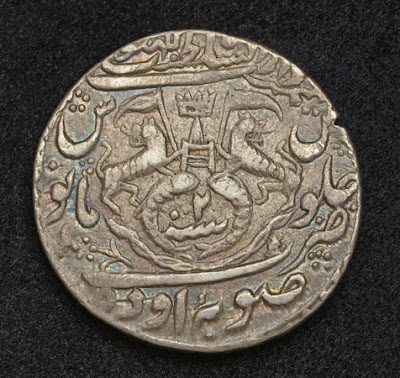 |
| Coins of India |
 |
| India coin |
World coins - India Silver Rupee issued by Ghazi-und-Din Haidar, King of Awadh 1820
Obverse: Crown above Katar dagger, flanked by rampart lions holding flag. Two upright fish flanking regnal year (7) below. Legends around.
Reverse: Legends in four lines with date (AH 1236) in third field.
Coins of Ghazi-und-Din Haidar
After declaring himself as King, Ghazi-ud-Din Haider issued coins on his name instead of the Mughal emperor, Shah Alam II from AH 1234 (1818). His coins were completely different from his predecessors. The most important feature of his coinage was the introduction of his coat of arms on the reverse of coin, consisting of two fish facing each other, two tigers each holding a pennon for support and a Katar (a small dagger) surmounted by a crown symbolizing the king.
The katar or suwaiya (Tamil: கட்டாரி kaţţāri, Marathi: कट्यार katyaar, Hindi: कटार kaţār, Panjabi: kataa) is a type of push dagger from India. It is characterised by its H-shaped horizontal hand grip, which results in the blade of the sword sitting above the user's knuckles. Unique to South Asia, it is the most famous and characteristic of Indian daggers. Ceremonial katar were also used in worship.
Mint Place: Lucknow
Reference: KM-165.2. R!
Mint Year: 1820 (Reign Year 2)
Weight: 11.09 gram of Silver
Diameter: 25 mm